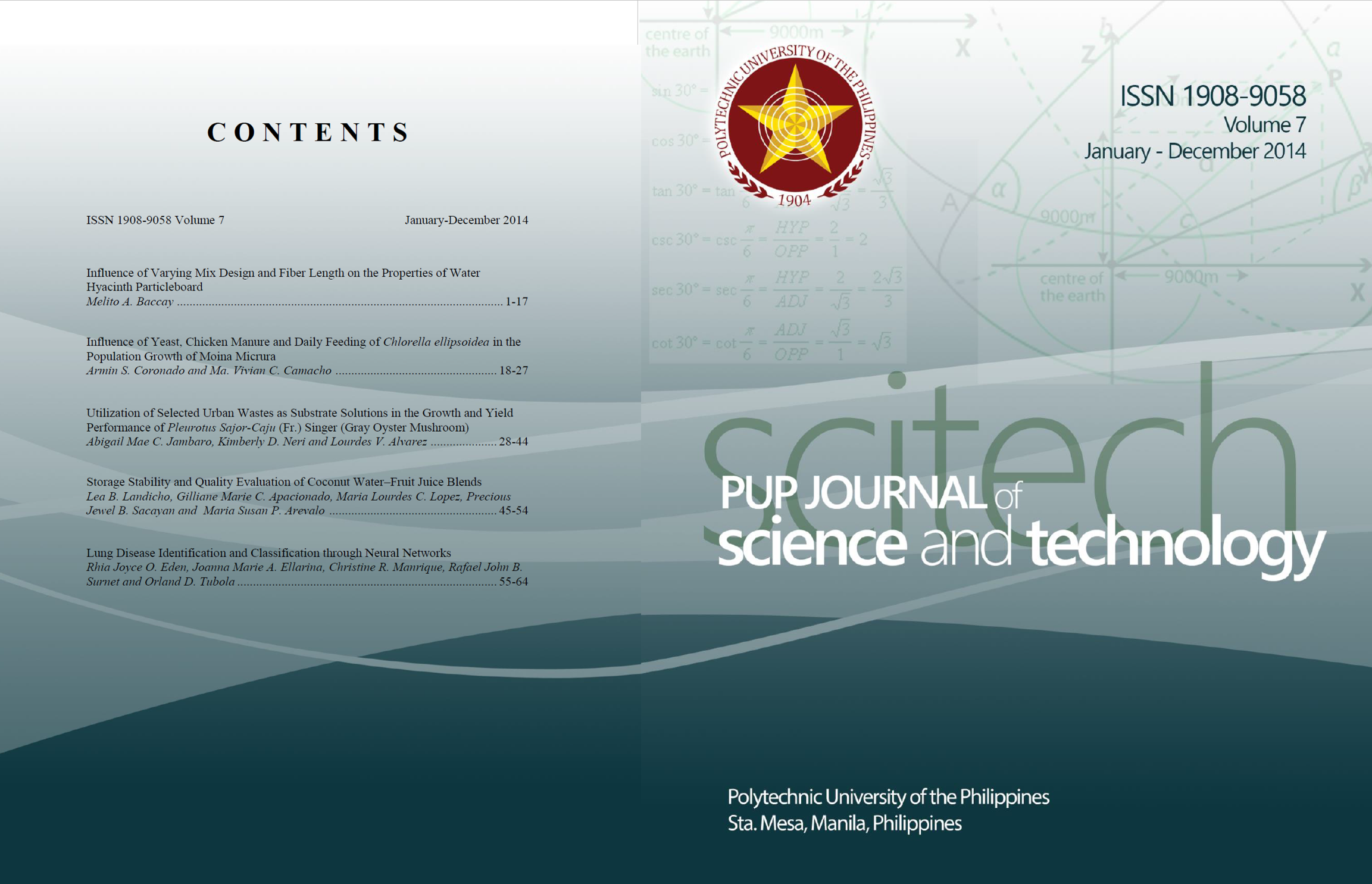Influence of Yeast, Chicken Manure and Daily Feeding of Chlorella ellipsoidea in the Population Growth of Moina micrura
DOI:
https://doi.org/10.70922/wfe1v423Keywords:
Moina micrura, size-class distribution, culture method, population growthAbstract
The total number of broods produced, daily fecundity and the size-class distributions of Moina micrura were determined in a four-day culture experiment to evaluate the effectiveness of rearing M. micrura in six culture methods. This study shows that addition of yeast, chicken manure and daily feeding of Chlorella ellipsoidea are the effective protocols in culturing M. micrura, which produced a significantly higher number of individuals (708 ± 66 individuals) compared with no yeast, no chicken manure and non-daily feeding of C. ellipsoidea. Higher production of M. micrura in chicken manure could be attributed to bacteria proliferation, which serves as additional food for the zooplankters, as well as to the products synthesized by bacteria to enhance growth. Daily feeding of C. ellipsoidea also contributed to high brood production of M. micrura, which may be attributed to the presence of certain nutrients necessary for growth and development of cladocerans. The proportion of neonates, juveniles and adults did not differ significantly among treatments but the lengths of developmental stages were significantly different among the treatments. Knowing the size-class distribution of M. micrura is important since this would allow determination of appropriate feed for fish with various gape sizes.
Downloads
References
Alam M.J., K.J. Ang, S.H. Cheah, M.A. Ambak and C.R. Saad. 1993. Effects of Moina micrura (Kurz) from two different culture sources as a replacement of Artemia spp. In production of Macrobrachium rosenbergii (de Man) post-larvae. Aquaculture and Fisheries Management, 24:47-56.
Amornsakum T., W. Sriwatana and U. Chamnanwech. 2003. The culture of sand goby, Oxyeleotris marmoratus I: feed and feeding scheme of larvae and juveniles. Songklanakarin. Journal of Science and Technology, 25 (3): 367-371.
Brett M.T. and D.C. Muller-Navarra. 1997. The role of highly unsaturated fatty acids in foodweb processes. Freshwater Biology, 38:483-499.
Dhert P., L.C. Lim, P. Candreva, H. Van Duffel and P. Sorgeloos. 1997. Possible applications of modern fish larviculture technology to ornamental fish production. Aquarium Sciences and Conservation. 1:119-128.
Faruque M.M., K. Ahmed and M.M.A. Quddus. 2010.Use of live food and artificial diet supply for the growth and survival of African catfish (Clarias gariepinus) larvae. World Journal of Zoology. 5(2):82-89.
Hardy E. R. and A. Duncan. 1994. Food concentration and temperature effects on life cycle characteristics of tropical cladocera (Daphnia gessner Herbst, Diaphanosoma sarsi Richard, Moina reticulate Daday): I. Development time. Acta Amazonica. 24:119-134.
Indulkar S.T. and Belsare S.G. 2004. Live and inert foods for postlarvae of the giant freshwater prawn Macrobrachium rosenbergii. The Israeli Journal of AgricultureBamidgeh. 56(1):45-50.
Innes D.J. 1997. Sexual reproduction of Daphnia pulex in a temporary habitat. Oecologia. 111:53-60.
Liao I.C., H.M. Su and E.Y. Chang. 2001. Techniques in finfish larviculture in Taiwan. Aquaculture. 200:1-31.
Macedo C.F. and R.M. Pinto-Coelho. 2001. Nutritional status response of Daphnia laevis and Moina micrura from a tropical reservoir to different diets: Scenedesmus quadricauda and Ankistrodesmus gracilis. Brazilian Journal of Biology, 61 (4): 555 - 562.
Maruyama I. and K. Hirayama. 1993. The culture of the rotifer Brachionus plicatilis with Chlorella vulgaris containing vitamin B12 in its cells. Journal of the World Aquaculture Society. 24: 194 - 198.
Mayer C.M. and D.H. Wahl. 1997. The relationship between prey selectivity and growth and survival in larval fish. Canadian Journal of Fish. Aquatic Sciences, 54: 1504 - 1512.
Mostary S., M.S. Rahman and M.A. Hossain. 2007. Culture of rotifer Brachionus angularis Hauer feeding with dried Chlorella. University Journal of Zoology Rajshahi University, 26:73-76.
New M.B. 1998. Global aquaculture: current trends and challenges for the 21st century. In: Anans do Aquacultura Brasil. 98 (I). Nov. 2-6.
OlurinK.B. and A.B. Oluwo. 2010.Growth and survival of African catfish (Clarias gariepinus) larvae fed decapsulated Artemia, live Daphnia, or commercial starter diet. The Israelii Journal of Aquaculture-Bamidgeh. 62 (1): 50 - 55.
Qin J.G. and D.A. Culver. 1996. Effect of larval fish and nutrient enrichment on plankton dynamics in experimental ponds. Hydrobiologia. 321:109-118.
Rottman R.W., J.S. Graves, C. Watson and R.P.E. Yanong. 2002. Culture techniques of Moina: the ideal daphnia for feeding freshwater fish fry. Circular 1054. Institute of Food and Agricultural Sciences. University of Florida. 6 pages.
Rojas N.E.T., M.A. Marins and O. Rocha. 2001. The effect of abiotic factors on the hatching of Moina micrura Kurz, 1874 (Crustacea: Cladocera) ephippial eggs. Brazilian Journal of Biology, 61 (3): 371 - 376.
Sipauba-Taveres L.H. and A.M.L. Pereira. 2008. Large scale laboratory culture of Ankistrodesmus gracilis (Reisch) Korsikov (Chlorophyta) and Diaphanosoma biergei Korinek, 1981 (Cladocera). Brazilian Journal of Biology, 68 (4): 875 - 883.
Sipauba-Tavares L.H. and M.A. Bachion. 2002. Population growth and development of two species of cladocera, Moina micrura and Diaphanosoma birgei, in laboratory. Brazilian Journal of Biology, 62 (4A): 701 - 711.
Yu J.P., K. Hirayama and V. Hino. 1994. The role of bacteria in mass culture of the rotifer Brachionus plicatilis. Bulletin of National Research Institute of Aquaculture. 1: 67 - 70.
Downloads
Published
Issue
Section
License
Copyright (c) 2015 PUP Journal of Science and Technology

This work is licensed under a Creative Commons Attribution-NonCommercial 4.0 International License.







